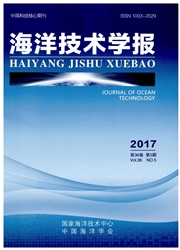

 中文摘要:
中文摘要:
锥形振荡浮子在波浪能转换装置中应用非常广泛,在其服役期间,由于较小的设计吃水深度或为防避极端海况的需要,它们经常会离开水面;当其再次入水的时候,浮子底部就会受到入水冲击。入水冲击总是伴随着巨大的冲击压强以及冲击载荷,会导致浮子的结构性及疲劳性破坏,从而影响浮子的工作寿命。基于Fluent软件对锥形浮子的入水冲击过程进行了模拟仿真,研究了具有不同斜升角的锥体在入水冲击过程中所受的冲击压强、冲击载荷、冲击速度的时空变化规律,以及各冲击参数之间的关系。结果发现:(1)锥形浮子在入水瞬间的毫秒量级时间内受到极大的冲击压强和冲击载荷;(2)最大压强出现在锥顶点处,且锥顶点压强和锥表面压强之间的差距随着入水深度的增加而逐渐减小;(3)锥顶点压强峰值早于冲击载荷峰值而出现,并且两者之间的时间间隔随着锥体斜升角的增加而增大;(4)其他条件不变时,斜升角越小的锥体其所受的入水冲击越大。
 英文摘要:
英文摘要:
Conical point absorber buoys have been widely used in wave energy converters. During their service periods, they may often rise out of the water for some reasons in the cases that they are designed with a small draft or being lifted to avoid extreme sea conditions. Therefore, it is normal for them to be subjected to bottom slamming upon its reentering the water. Bottom slamming, known as water entry impact, is typically associated with large impact pressures and forces, which may lead to serious fatigue and structural damage to the buoys and shorten their working lives. In this paper, the water entry impact of conical buoys with different deadrise angles is numerically studied based on the FLUENT software. The variation of the impact parameters, including impact pressure, speed, load during water entry, is presented and the temporal and spatial relationships among the parameters are analyzed in this paper. The main conclusions are as follows:(1) The conical buoy is subjected to large impact pressure and load at the first contact with water in short duration of milliseconds.(2) The maximum pressure occurs at the cone vertex, and the gap between the vertex pressure and the surface pressure decreases with the increase of water-entry depth.(3) The vertex pressure peak occurs earlier than the impact load peak,and the time interval between the two peaks increases with the increase of the deadrise angle of the cone.(4)Cones with smaller deadrise angles will undergo a greater water impact.
 同期刊论文项目
同期刊论文项目
 同项目期刊论文
同项目期刊论文
 期刊信息
期刊信息
